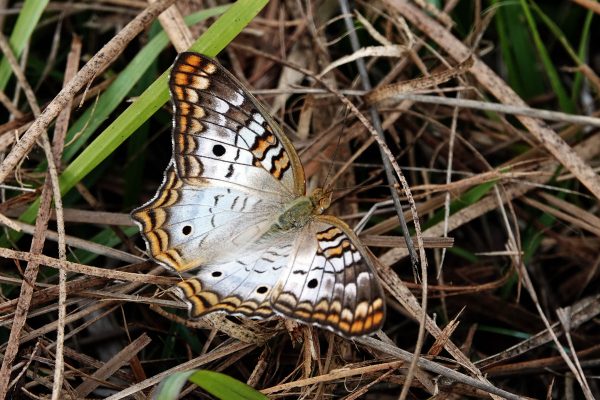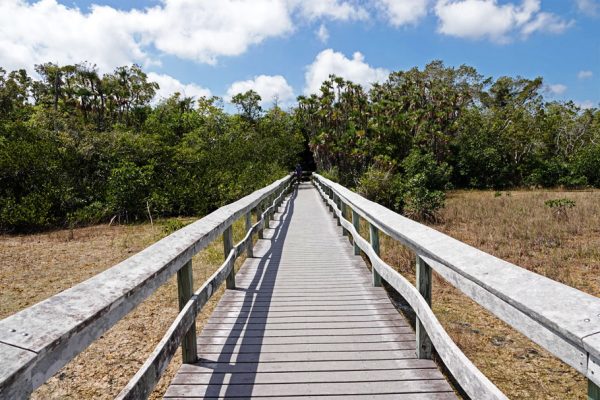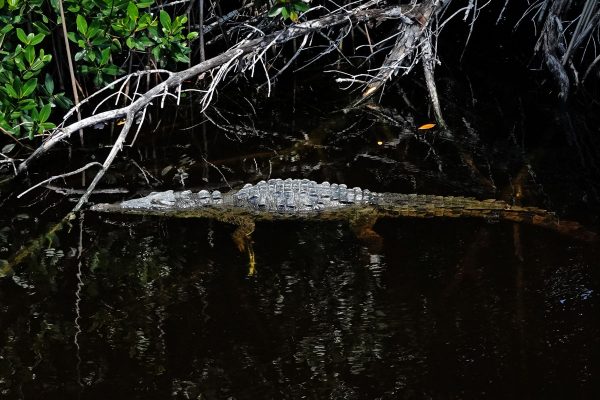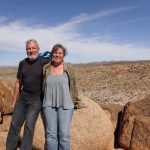
March 13 – 18 & April 17 -19, 2021.
“But it all looks like — this.” It was both a question and a judgment. The woman who voiced it had just listened to a Park Ranger describe some of the things to see and do in the northwest Everglades.
We were waiting behind her with our own questions about kayaking in the 10,000 Islands. The ranger was very diplomatic. She smiled and said, “I guess we just look at things differently”.
I could relate to both perspectives. I grew up in southern Florida. At the time, it was less than a two-hour drive to the Everglades. We did at least one family trip there, but I never went back exploring.
To me, Florida was flat, hot, humid, and boring. (Except for the beach, of course.) The Everglades was a superior example of all of those qualities.
But Duwan hadn’t been there, so she should have a chance to see it. And, we’ve read that the birds like the glades. In fact, it’s the only place in the US to spot some species.
So we went. It was a blast. And I learned, once again, that if you’re bored in this world, you’re just not paying enough attention to what’s going on around you.
– Greg
* All pictures are click to enlarge. Once enlarged they can be viewed in a slideshow. Hover over the pictures in tiled mosaics for captions.
** This is the first of four posts that include places we visited in the Everglades. See all of our Everglades posts here. See The Everglades Part II post here.

Shark Valley Visitor Center
We didn’t have a plan before we set out for the Everglades National Park so we did what we usually do in National Parks – head for a visitor center for more info. Traveling south to the park, the closest visitor center appeared to be Shark Valley on the Tamiami Trail (Highway 41 which stretches across the state from Miami to Tampa). It was a Saturday. We usually try not to start adventures on the weekend to avoid crowds. So we weren’t too surprised that we found a crowd when we arrived. What was surprising, though, was that they didn’t have enough parking to accommodate this crowd and were only letting cars through the gate one at a time as parking spots opened up. A line of autos stretched back toward Tamiami.
But the Everglades is rich with details everywhere you look. Outside the van, a canal ran along the road leading into the park and it was full of wildlife. An alligator, an egret, herons, crows. I started taking lots of pictures out my window as we inched forward. I was having so much fun, it was a bit of a disappointment when we finally got through the gate.
Once parked at the visitor center we learned that Shark Valley features a 15-mile paved trail with a huge observation tower at the end of it. You can buy tickets for a two-hour tram tour to the tower. You can also rent, bring your own bikes, or walk the paved trail as well as a few shorter trails.
We stopped at this visitor center twice. After our initial trip to the Everglades in March, we made an impromptu return trip in April. On our first visit, we just picked up brochures and moved on since it was Saturday and due to our lack of planning we needed to secure a camping spot. On our second visit, I wanted to see what we missed previously. More lack of planning brought us here again on a Saturday. Despite once again breaking our rule not to arrive at new places on weekends we felt the sweltering Florida temperatures of spring would probably keep the crowds at bay. We were wrong. When we got to Shark Valley that morning we found another line of cars backed up to the highway a half hour before the park even opened.
But once again it was fun waiting in line. People jumped out of their vehicles and scrambled to a ditch to watch an alligator swim by.
On this visit, we walked two short trails – the Bobcat Boardwalk Trail and the Otter Cave Hammock Trail. We saw neither bobcats nor otters on either trail or any other wildlife. The main, Shark Valley Loop Trail was abundant with wildlife, though. We just walked a mile or two of it but it was an amazing and lovely introduction to the park – worth waiting in line.


Long Pine Key
We were relieved to find several empty campsites at Long Pine Key when we arrived on that first Saturday afternoon in March. Of the two campgrounds in the park and Long Pine is definitely the prettiest. Lots of tall pines surround each campsite. There is a nice lake to walk around or to just hang out by on a lazy afternoon. The campground hosts ranger programs every Friday, Saturday, and Sunday night (they might not run these in the off-season) at an amphitheater adjacent to the camping area. There are hiking trails leading out of the camping area. But one of the best things was the wood storks we saw many mornings hanging out in the trees at the turn-off from the park’s main road leading to the campground.

Pinelands
On day two of our Everglades adventure, we did what we usually do in a new park, a recon of the area. We drove from our campsite at Long Pine down the Flamingo Lodge Highway, a 47-mile road that runs from one end of the park to another, to the Flamingo Campground at the end of the road. Along the way, we stopped at most of the easily accessible small boardwalks and short hiking trails. Right before the Flamingo Campground, we stopped at the Flamingo Visitor Center – just a small trailer for the time being. The real visitor center had been destroyed in a hurricane and they were currently in the process of rebuilding this big facility. At the trailer, we got info about hiking and kayaking in that part of the park. After that, we checked out the Flamingo campground and decided to camp there for a few days.
Pinelands was our first stop on our recon. This 1/2 mile trail featured a subtropical pine forest. This is also where we first realized that we needed to be diligent about applying the bug spray. Lots of bug spray. This is also when we realized that we didn’t bring enough bug spray with us and would have to shell out a few extra dollars to buy an overpriced can at the store at the Flamingo Marina.
Dwarf Cypress
This is just a little tiny boardwalk leading from the main road. It isn’t even on the park brochure map. A nice stop considering we saw a fun lizard, a Peter’s Rock Agama. These colorful lizards aren’t native to Florida. They were introduced from western Africa in 1976.
Pa-hay-okee Overlook
Pa-hay-okee is a Seminole Indian phrase meaning “grassy waters.” A quarter-mile boardwalk loop takes you to a view of the saw grass prairie and the Shark River Slough.

Mahogany Hammock
Mahogany Hammock is a 1/2 mile boardwalk loop into a subtropical tree island with massive mahogany trees. We visited this hammock a few times. Our first visit in the morning netted us lots of wildlife observations. Our second visit was in the afternoon and everyone seemed to be asleep. We would find out that timing was often key to enjoying the trails and walks in various parts of the park.


Flamingo Marina
Nearly at the end of the Flamingo Lodge Highway, we found the Flamingo Visitor Center trailer and the Flamingo Marina. At the marina, you can pay for boat tours into Florida Bay at the very bottom of the state, rent kayaks and canoes, stock up on gifts and snacks at the marina store. You can also see lots of wildlife including manatees that come into the marina to feed on aquatic plants growing on the sides of the marina’s seawalls.

Nine Mile Pond
On day two we went on our first kayak trip. A kayak trail marked with numbered white poles makes a loop through Nine Mile Pond. The trail is five miles with a shortcut that turns it into three miles. Since we had previously paddled five miles with relative ease we decided to take the long way. After we spent three hours traversing the first 2 1/2 miles of the loop we realized that perhaps five miles was a bit much for the poky pace we have adopted since becoming birders. We sped up for our return trip only to find ourselves paddling through a thick expanse of periphyton – a soft spongy mat of algae. It was like paddling through a sea of goop.
Despite the difficulty of our return trip – the paddle was beautiful. We went through mangrove tunnels, traversed tight spaces, pulled ourselves through reeds, heard the loud grumbling of crocodiles as we paddle past trying not to get too close, and took a few pictures of birds.

Flamingo Campground
After two nights at Long Pine campground, we switched to Flamingo. The Flamingo Campground was closer to many of the things we wanted to do and being close to Florida Bay we got a better breeze.
The campground has two big loop sites, one for RVs with a limited number of electric hookups and one for tents. There is also a walk-in tent camping area right on the Florida Bay and Eco tents with beds, dressers, floor fans, and electricity available for rent.


Their tongues are twice as long as their beaks and barbed at the end so they can stab grubs for retrieval. The tongue splits at the base of the skull and each half wraps over the skull’s top.
You wouldn’t be able to spot the red belly of this Red-bellied Woodpecker unless you turned it over in your hand. The pattern of the red atop its head tells you its species.
Eco Pond
Eco Pond was one of our favorite stops in the park and we visited here often. Located right off the main road not far from the campground at Flamingo, it was convenient to stop every morning as we headed out exploring. The pond trail is a short half-mile loop with a deck overlooking the pond in the middle. We saw different birds almost every time we visited.
One of our favorite birds to watch was the Reddish Egret.
The Reddish Egret doesn’t hunt for fish by standing and staring into the water as many wading birds do. It dances. It seems to start the day with a moment of reflection, gazing over the still pond water. Then it begins a gangly, yet graceful dance. It runs or leaps from one spot to the next, wings going in all directions. Occasionally it will hold a wing out, shading the water, and giving fish something to “hide” under. It pounces just when they feel safe.

I hope you enjoyed Part I of our Everglades blog. I really loved this park and took about a million pictures so there is more to come! Please let me know if you enjoyed the post in the comments section below. If you have been to the Everglades, do you have a favorite hike, kayak, overlook, animal? Do you have any questions about the Everglades or any of my wildlife pictures, hopefully, Greg or I can answer them.
It is quite possible that I will be sharing this post on any one of these sites this week: My Corner of the World, Travel Tuesday, Wild Bird Wednesday, Through My Lens, and Sharon’s Souvenirs. Check out these links to see what other people are doing all over the world!








































































I’m pretty sure there’s no way to ever see enough of nature. Lovely pictures and observations.
Thank you, Jacqui. You are right. Nature is quite overwhelming sometimes. Even though I take tons of pictures there are so many sights I just have to walk past or we wouldn’t ever get anywhere.
Thank you for another wonderful entry. Your wildlife photography is just extraordinary.
Thank you so much Rick! Surely you didn’t take time out from your whirlwind honeymoon to read my blog!
I am really enjoying your travels out west. Hope you guys are having a great time!
Awesome recap and photos!! When I first came to Florida I distinctly remembered how loud the birds were in the morning. It was a good thing but very odd to me. It was a Jan. and they had a freeze warning going on. That Shark Valley is very cool to explore and so much wildlife right there. I rented a bike, it was a great way to explore. I had forgot it was 15 miles though and had to hurry up in the end. Looks like you both enjoyed it and adding to your bird list. 🙂 I was able to rent a bike for free and do a tour with a Ranger, very fun and informative. Sad to hear about the damage to the visitor center from hurricanes. It was visible when I was there too. Being on the kayak you got to explore. I wanted to do that, another free Ranger program but due to rain it was cancelled. I’d love to go back one day and see more. Thanks for the post!! :*
Your welcome Tina! We got there at the end of the season so there weren’t many ranger programs. We so love ranger programs but i think we have just gotten used to them all being cancelled in 2020 that we don’t even look for them any more.
I would recommend to anyone who just wants an easy way to see some of the Everglades to check out Shark Valley. I was so glad we went back.
I hope you get a chance to go back someday – after you conquer the west which you seem to be doing a pretty good job of lately!
Thanks, as always, for taking us along on your journeys. And you may have answered a question I’ve had for a while. You guys use inflatable kayak(s) correct? Bcuz I do, too, and I’m planning a trip to the Everglades but I didn’t know if they allowed inflatable kayaks since friends of mine in Florida think I’m nuts for wanting to go into alligator central with an inflatable. Since when did alligators add denier to their diet? Or do they just snap and bite at anything passing by? You guys survived so I’m not so worried anymore.
Hey Craig! Yes, our kayak is a tandem inflatable. We went with an inflatable because it folds up and fits in the van.
About the alligators (and crocodiles), here is a story not to tell your friends — while we were kayaking in Big Cypress National Preserve which is adjacent to the Everglades NP we were going through a mangrove tunnel – this tunnel was shallow and close, we were only using half a paddle to get through it and often times had to use our hands to pull ourselves along – when all of a sudden there was an alligator swimming right past the boat going the other direction. He was so close if Greg hadn’t been paddling on the other side at that moment he would have brought the paddle right down on him! It was quite startling. I’m sure the alligator saw us long before we saw him and all he wanted to do was to swim on by.
So, I can say from experience that they don’t snap and bite at anything passing by but keep an eye out and don’t bring a paddle down on them.
The Everglades Part II post will have one of my favorite kayaking experiences in the Everglades. The scariest thing we saw on that trip was just sharks.
So enjoyed this post. A piece of Florida people don’t see.
Thank you Brenda! After walking around your neighborhood for a couple of weeks I wondered why we even went to the Everglades – you have such amazing wildlife right where you live.
Thus brings back great memories of time spent birding in south Florida, spread over several years. The Everglades are simply superb – a never end feast for the ears and the eyes. You could stay there for a year and still not unlock all its secrets. Thanks for visiting my blog. I will look forward to following your adventures.
I’m not sure we would have spent so much time in the Everglades before we became birders. And I was so surprised at all the different species we saw on our return trip a few weeks ago (more for the next Everglades post). I wouldn’t mind returning to the Everglades often.
Thanks for your comment and for visiting our blog! I enjoyed your Travels With Birds today!
The Everglades National Park is an amazing place – love your photos!
Thanks Carol! So glad life brought us down to Florida and we got to visit. The Everglades might be one of my favorite National Parks now.
I absolutely enjoyed your tour of the park.. Your wildlife photography is incredible!
Thanks so much, Veronica! It’s an amazing park.
Wow! You really saw some great wildlife. I have always wanted to visit the Everglades.
The wildlife is everywhere! I highly recommend it!
Gorgeous wildlife pics. So many wonderful birds.
A big thank you.
Thank you Dixie for stopping by the blog. The birds truly are wonderful in the Everglades.
Wow! What an exciting place with so much to see! Your photos are just remarkable to see.
Thanks for being a part of ‘My Corner of the World’ this week!
There is so much to see! Thank you so much.
I’ve never been to the Everglades, but am always amazed by the plant and animal diversity. Your photos are wonderful and really make me want to visit!!
Thank you Peter! It is so different in Florida after spending so much time in the desert – so many plants and animals.
Love the new look of the blog, Duwan! Well done. And you seem to be attracting a lot of new readers and commenters. It’s nice to read Greg’s introduction to this post and – of course – your photos are stunning as always. I swear your eyes are trained to find and snap birds.
Mark and I (and Maya who had to stay in the van, so we needed an early start and park in the little shade that was available) stopped at Shark Valley when the pandemic just started in the US. The visitor center was closed (and the tram didn’t run) and there was plenty of parking space. Mark and I biked that loop and it was wonderful. Unfortunately, we were in a hurry as we didn’t want to leave Maya in the car for more than two hours. It was already super hot here early March last year.
It’s great to read about all the different areas you explored. I do think taking your time and being able to use your own kayaks broadens the experience. On my first visit to the Everglades (must have been in 2003), my ex and I rented kayaks and went out from Flamingo into the bay. We managed to kayak with dolphins back then, which left an impression.
Thanks, Liesbet – After seeing your blog the other day, I think we are now both using the same theme. My old theme was self-built and didn’t work well with the photo gallery I wanted to use to display my many many Everglades photos so I needed to change themes. I’m pretty happy with this one.
I think Shark Valley is a good introduction to the Everglades and probably the easiest and best stop if you have little time. I was so amazed at all the wildlife and how accessible it was. We also did a kayak in the bay (I left this for Part II of the post). We did it on our return trip to the Everglades and I was so glad we got the opportunity. We didn’t see any dolphins but we did see sharks – and lots of other really cool birds (surprise for the next post).
Yes, Florida is hot. We have been pretty lucky with the weather but I think there is no escaping the heat now – time to escape Florida.